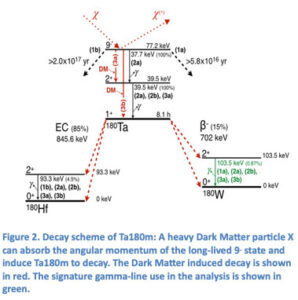Using this unique quality to their advantage, a group of physicists, led by Björn Lehnert (LBL) and Harikrishnan Ramani (LBL, UCB), is setting world-leading limits on exotic Dark Matter. The results of their work were recently published in Physical Review Letters [1].
But Ta180m is even more unique: Its meta-stable state (m) is by far the most stable in nature. Its decay has never been observed, living longer than 4.5×1016 years (90% credibility). This was determined in 2016 by low-background gamma-spectroscopy at the underground laboratory, HADES, Belgium [2]. Lehnert and Ramani re-analyzed this data to search for Dark Matter they hypothesized could interact more strongly than previously thought. Under this assumption, Dark Matter loses its galactic velocities when colliding with the atmosphere and earth. Upon reaching underground laboratories, the thermalized Dark Matter does not have enough kinetic energy to create a signal in traditional experiments. However, it can de-excite Ta180m creating an observable gamma-ray signature. These gamma-rays, undetected in the analysis, are used to set the most stringent constraint for this Dark Matter scenario.
 Because this project represents a very successful collaboration between theorists and experimentalists and also between the Physics and Nuclear Science divisions at Berkeley Lab, the scientists are now looking toward future experiments. Alternative detector technologies such as thick, segmented large-area semiconductors or a tantalum crystal operated as a bolometer are being discussed with the local experts at NSDs Semiconductor Detector Laboratory and bolometer experts from the CUORE experiment.Further work in this area, however, comes with inherent obstacles. With only 0.012% isotopic abundance in the rare earth element tantalum, Ta180m is the rarest stable isotope known in nature. While this makes it “famous” even outside nuclear physics circles [3], it is difficult to acquire large target masses. Isotopically enriching a sample in Ta180m could be a game-changer to improve the sensitivity of future Dark Matter searches.
Because this project represents a very successful collaboration between theorists and experimentalists and also between the Physics and Nuclear Science divisions at Berkeley Lab, the scientists are now looking toward future experiments. Alternative detector technologies such as thick, segmented large-area semiconductors or a tantalum crystal operated as a bolometer are being discussed with the local experts at NSDs Semiconductor Detector Laboratory and bolometer experts from the CUORE experiment.Further work in this area, however, comes with inherent obstacles. With only 0.012% isotopic abundance in the rare earth element tantalum, Ta180m is the rarest stable isotope known in nature. While this makes it “famous” even outside nuclear physics circles [3], it is difficult to acquire large target masses. Isotopically enriching a sample in Ta180m could be a game-changer to improve the sensitivity of future Dark Matter searches.
References
[1] B. Lehnert et al., “Search for Dark Matter Induced Deexcitation of 180Ta-m,” Phys. Rev. Lett. 124, 181802 (2020)
[2] B. Lehnert et al., “Search for the decay of nature’s rarest isotope 180mTa,” Phys. Rev. C 95, 044306 (2017).
[3] Science News, Rarest nucleus reluctant to decay https://www.sciencenews.org/article/rarest-nucleus-reluctant-decay (2016)
